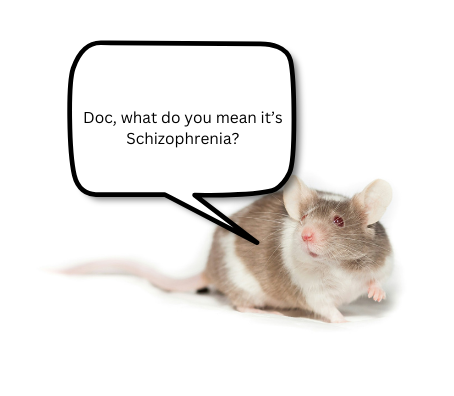What do you mean this mouse has Schizophrenia? – Mice models in Schizophrenia Research
By: Hannah Olson
You’ve seen the headlines that go, “Mice with Schizophrenia are twice as likely to …”. Obviously, these headlines are based on powerful scientific research and findings, but in the back of my mind I ask myself, “How do mice get Schizophrenia?”. I don’t feel very smart nor scientific when I ask myself that, but these articles really don’t talk about how these mice came to be (granted they are likely talking about the more serious human implications).
Why Do We Need Animal Models?
In an article on this subject by Dr. Bryce from the University of Missouri, titled, “The Mighty Mouse: the Impact of Rodents on Advances in Biomedical Research”, She explains the reasons that mice models are used for research: Historical, Economical, and Physiological.
Historically, use of human models has been unethical and is now illegal. Other animal models have been developed to use instead of the human models like zebrafish, fruit flies, primates or mice.
Physiologically, primates and mice are ideal candidates because of how closely their brains and bodies are to humans. For example, mice and humans each have around 30,000 genes, and 95% are shared between the two species. Additionally, both human and mouse genomes have been sequenced so geneticists (people who work and study genes) can compare the genes between the two.
Economically, mice are better than primates because of their shorter life cycle and because they need less space and food for care of these animals.
Due to these reasons, mice are one of, if not the most common animal model used in biomedical and psychological research which is where all those headlines originate from.
How Do Mice Get Schizophrenia?
So now we know why we need mice, but how does a mouse get schizophrenia? According to the article by Winship et al. (written in 2019), there are three ways used to induce (give) schizophrenia in a mouse.
-
Drug Induced
Just as it sounds, drug induced models are when a mouse is dosed with drugs to induce schizophrenia-like symptoms. The most common drugs used are amphetamines like methamphetamine or Adderall.
- Genetic Modification
Mice in this category are genetically modified while the mice are still in the womb. The genes that are modified are not random. A scientist will choose the genes to change based on past information gathered about which genes might cause schizophrenia in humans.
-
Developmental Modification
In these mice, their regular development in the womb is disrupted. This is usually done in one of two ways. Way 1 being stressing the mother whether that be with sleep-deprivation, poor diet, etc. Way 2, the most common, is to inject a drug into the fetal mouse. The drug injection has become so common for inducing schizophrenia in mice that it has become protocol to inject it on day 17 of gestation (pregnancy).
Now we know how mice “get” schizophrenia and why they are important for medical research.
References
[1] Bryda, E. C. (2013). The Mighty Mouse: The Impact of Rodents on Advances in Biomedical Research. Missouri Medicine, 110(3), 207–211.
[2] Photo by Kanashi on Unsplash
[3] Winship, I. R., Dursun, S. M., Baker, G. B., Balista, P. A., Kandratavicius, L., Maia-de-Oliveira, J. P., Hallak, J., & Howland, J. G. (2019). An Overview of Animal Models Related to Schizophrenia. Canadian Journal of Psychiatry. Revue Canadienne de Psychiatrie, 64(1), 5–17. https://doi.org/10.1177/0706743718773728
